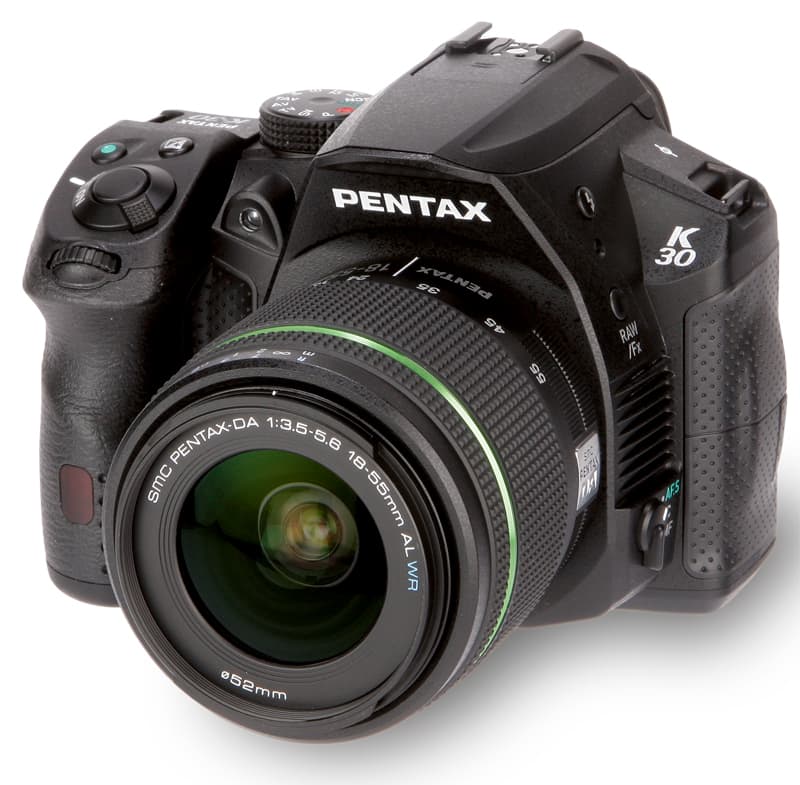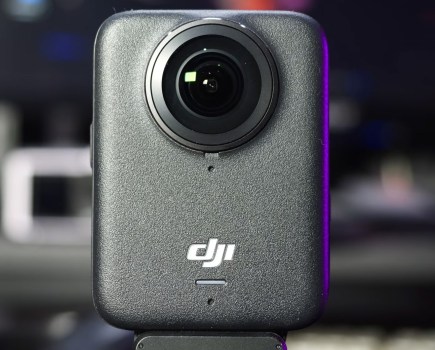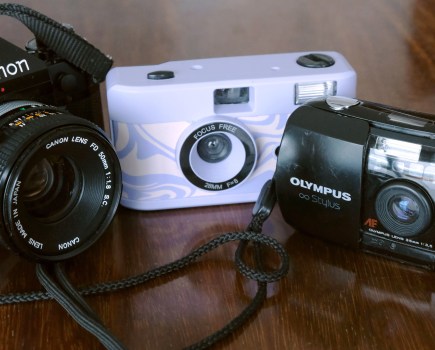Pentax K-30 at a glance:
- 16.3-million-pixel, APS-C-sized
- CMOS sensor
- ISO 100-12,800, expandable to
- ISO 25,600
- Optical viewfinder with 100% field of view
- Weather-sealed plastic body
- 11-point AF with 9 cross-type points
- Street price around £650
Pentax’s range of interchangeable-lens cameras of the past year have all demonstrated bold design ideas. The Pentax Q is the smallest interchangeable-lens camera currently available, while the K-01 is the only compact system camera to use an existing DSLR mount (Pentax K) and is labelled ‘for those interested in design’ (and consequently less for those who simply desire intuitive handling). Although Pentax was acquired by Ricoh during the development of the K-30, it is unlikely that Ricoh had much involvement in the design of the camera.
As a DSLR, the K-30 is more conventional in its design than the Q and K-01, but nevertheless entertains some design quirks, such as its angular edges and a dotted rubber and ridged left-hand side. With the K-r no longer in production (although it is still available in some shops), the Pentax K-30 is now one of two Pentax DSLR models, and sits below the K-5 as the entry-level model.
Compared to other brands, the K-30 is an ‘upper’ entry-level camera, competing against models such as the Nikon D5100, Canon EOS 650D and Sony Alpha 57. Traditionally, Pentax DSLRs have had the sort of controls, shooting modes and handling that serious photographers appreciate, and offer more for their money. We expect the K-30 to be no different.
Features
Despite being Pentax’s entry-level DSLR, the core of the K-30 is heavily influenced by its bigger brother, the enthusiast-level K-5, which can only be a good thing. As with the K-01, the Prime M processor and imaging sensor are both updated versions of those in the K-5. The main refinement to the K-30’s 16.3-million-pixel, APS-C-sized sensor is its improved handling of HD video files, while the processor is claimed to improve live view and reduce energy consumption.
With a refined version of the K-5 sensor, we can expect the low-light performance to be very good. Indeed, DNG raw and JPEG files can be captured in a native ISO range of 100-12,800, which is expandable up to 25,600. The K-5 extends to ISO 51,200.
Like many other Pentax DSLRs, the K-30’s imaging sensor features shift stabilisation, which means that none of the company’s lenses requires optical stabilisation. The sensor-shift feature also enables vibration cleaning that can be activated on start-up and/or shut-down, a dual-axis electronic level gauge and the unique astrotracer shooting mode.
Photographers are likely to appreciate the volume of genuinely useful shooting modes. These include multiple exposure for up to nine frames (with the option for auto EV adjustment) and interval shooting for up to 999 frames down to 3sec intervals with the option to select the start time. Other useful features are correction for lens distortions, highlight and shadow information, auto horizon and composition adjustment.
A 6fps burst mode (the K-5 shoots at 7fps), 19 scene modes, seven digital filters (including toy camera) and HDR are also available. High-speed burst is possible for up to 30 full-resolution JPEG files, while the HDR mode offers a choice of three levels of strength, recorded in a single press of the shutter over three combined frames. Handily, for the custom image colour mode and the digital filters, a test image can be taken using the raw/fx button, and the effect of each filter viewed on that test image prior to shooting.

Image: The multiple-exposure shooting mode can combine up to nine frames and apply auto EV adjustments to the final image, which is the case in this three-frame exposure
Astrotracer

The Astrotracer function works in the bulb shooting mode and can be found in the GPS section of the in-camera menu, because it requires the optional GPS unit (around £175) in order to work. In short, astrotracer eliminates star trails during long exposures (up to 5mins), which is achieved by using information from the GPS signal, the angle of view and focal length of the attached lens. A calculation is made for the necessary physical movement of the imaging sensor during the exposure, in line with the star trails. According to Pentax, this function is unique to its cameras that use electro-magnetic sensor-shake reduction. Previously, an equatorial drive was needed to remove star trails.
I mounted the K-30 to a tripod and recorded an image for 4mins at f/8 and ISO 100 with the function activated, and repeated the same exposure with it disabled and compared the results (below). As you can see, with astrotracer enabled, the stars appear stationary and, consequently, the landscape is blurred. Conversely, with the function disabled, the star trails are evident while the landscape is crisp. With a little patience and the use of editing software, it is possible to combine the crisp elements of each exposure for a striking final image.
Build and handling

Image: Several times I was caught in the rain with the K-30, and the camera’s weather seals do an excellent job of keeping out rain and moisture. Note that this image is not taken with a K-30
One cannot help but explore the edges and curves of the Pentax K-30’s body. It may be a conventional DSLR, but its unusual shape draws the eye. The corner next to where the thumb rests, the built-in flash and the ridged and rubber side all offer a break from the norm. However, these quirks are only skin-deep, and offer no practical advantage.
Key differences between entry and enthusiast-level DSLRs are typically those of construction (low-cost polycarbonate rather than magnesium alloy) and the lack of an LCD on the top plate. This is indeed the case here, but despite its plastic shell the K-30 features a metal chassis and a weather-resistant body that is claimed to withstand splashes, and it will work in freezing temperatures down to -10°C. This is the first DSLR introduced at this level and price point to offer a weather-resistant build.
During this test I had plenty of opportunities to take Pentax up on its invitation to test the K-30’s weather seals. As a result, I would not hesitate to use the camera in the rain, with the seals successfully keeping out raindrops and moisture.
Another major part of the redesign is the handgrip, which is deep and well contoured for a comfortable grip, whether shooting in landscape or portrait format. All the buttons are well spread over the body and are large enough for easy use even with gloved hands.
Despite the flash head featuring an angular exterior lip, the flash unit itself within the head is set back, not making the most of the design. That said, there is still a good distance between the flash unit and the lens, which reduces the likelihood of redeye.
The design of the battery compartment is similar to that of other Pentax DSLRs, with space not only for a D-LI109 lithium-ion battery, but also for an optional 4x AA battery pack. This is a great idea if the primary battery runs out, but it does mean that the supplied Li-Ion battery is a physically small unit and one that does not have an overly impressive capacity, allowing approximately 450 shots from a full charge. A higher-capacity Li-Ion battery would perhaps be the better choice, although this type of battery is significantly more expensive than the AA type.
There are several exposure modes on the shooting-mode dial. The usual program, aperture priority, shutter priority and manual controls are all present, as are bulb, two custom settings, scene, sensitivity priority, and shutter and aperture priority. These latter two modes adjust the ISO rating according to the selected shutter speed and aperture. As well as a host of shooting modes, the camera offers a maximum 1/6000sec shutter speed, and drive modes that include exposure bracketing up to ±5EV. The timed-delay drive mode activates mirror lock-up (there is no option for mirror lock-up in the menu, other than for sensor cleaning) and ensures the camera is as steady as possible to record crisp detail.
Unusually for an entry-level DSLR, the K-30 has twin control dials: one on the front and one on the rear. This speeds up changes to exposure settings within the menu, as well as playback, where one dial controls the zoom and the other navigates between frames. It is possible to maintain the magnification when scrolling through images, which is handy for comparing details in consecutive frames.
For those controls that do not have direct access on the body, they can be found via the info button, which opens a function menu of 15 settings, including AF mode and AF points, file size and format, metering mode, distortion corrections and the sensor-based stabilisation. Press the info button a second time and the status of the LCD screen can be selected, with options for an electronic level, display ‘off’ or the ‘status’ screen that displays the exposure settings.
White balance and colour

Image: There are colour filter effects in the monochrome colour mode, including one for infrared, which is shown in this image. The effect is applied well in sky areas, but it is less convincing when applied to foliage
It is easy to choose between the different colour modes and white balance settings. In the custom image colour mode, there are 11 options, including natural, cross-processing and monochrome, all of which can be adjusted for saturation, hue, high/low key, contrast and sharpness. In the black & white mode, a filter effect can be applied, which includes green, red and a (mildly convincing) infrared effect.
Similarly, all the white balance settings – AWB plus 10 presets including four fluorescent light settings – can be adjusted for hue, while Kelvin and manual settings are available with space for three further saved settings. Any changes to the colour can be checked for the current scene by pressing the raw/fx button for an on-screen preview image – a truly handy feature.
With the camera set to its standard (natural) colour mode, there is little need for colour adjustments post-capture. Greens in landscapes are pleasant, and vibrant colours are kept true without overdoing the saturation. Having used all the colour modes for various scenes, I was happy to stick with the natural colour mode, except when experimenting with the black & white mode and digital filter effects.

That said, most of the black & white effects can be applied post-capture.
Tonal detail can be lost in vibrant red subjects during JPEG compression, but otherwise the main differences between JPEG files and uncompressed raw files is the brightness of midtones – JPEGs are more vibrant, without compromising a faithful representation of the colours.
Image: In this unedited JPEG file, shot using AWB, skin tones are a touch on the cyan side
Autofocus
The Pentax K-30 makes use of an updated Safox IXi+ AF sensor module. This features 11 AF points, nine of which are the more sensitive cross-type, with 11-point, 5-point, centre-point or individually selectable point modes, and options for face detection and tracking AF (both of which work in video and stills capture).
The lenses in front of the module have also been improved, with Pentax stating that the new lens minimises chromatic aberrations – a factor that inhibits the consistency and effective operation of an AF system. A ‘select-area expansion’ function is also new – for continued subject tracking even when the subject moves out of the pre-assigned auto-tracking area.
In a variety of lighting conditions and using different standards of lenses, the contrast-detection AF system is speedy and, on the whole, accurate. Even in low-contrast light, with the help of the AF assist beam, the camera is able to focus on close-range static subjects with ease and minimal ‘hunting’. It is important, however, to select the ‘correct’ option for the scene to achieve speedy and accurate AF, otherwise the camera can struggle. It is in such situations, when using the 18-55mm kit lens, where noisy AF becomes obvious. This is a major gripe I have with most Pentax AF lenses – it is hard to remain unobtrusive when using AF. In this respect, the camera feels clunky, even though it is, on the whole, snappy.
I have not directly compared the new Safox IXi+ AF sensor module when tracking moving subjects in the K-30 against the older version in the K-5, but in its own right the new module is suitable for its target audience. Slow-moving subjects are tracked with accuracy, but for fast subjects and low-light action shots, a more sophisticated system is required.
Metering

Image: The auto metering has produced a dark exposure here, but I can bring back the levels by +2EV before shadow noise becomes an issue to reveal good detail in shadow areas
With the same 77-segment metering system as found the Pentax K-5, it comes as no surprise that the K-30 behaves in exactly the same way. The spot, centreweighted and multi-segment modes are accessed via the info button or through the main menu. Multi-segment metering, on the whole, produces exposures erring to the highlights, which often results in dark midtones and shadow areas. However, this is not too much of a problem because the camera’s dynamic range is very good and there is plenty of recoverable detail from these dark areas.
There is the option to link the autoexposure to the active AF point, which is the only way to achieve spot metering outside of the centre point. I found adjusting the metering appropriately to each scene a little slow, so for general use I stuck to multi-segment metering and made tweaks to the exposure via the twin manual exposure control dials. Overall, I had to adjust the exposure more often than I would have liked.
Noise, resolution and sensitivity

These images show 72ppi (100% on a computer screen) sections of images of a resolution chart, captured using the 18-55mm f/3.5-5.6 kit lens.
We show the section of the resolution chart where the camera starts to fail to reproduce the lines separately. The higher the number visible in these images, the better the camera’s detail resolution is at
the specified sensitivity setting.
With a refined version of the 16-million-pixel sensor that has received such praise in cameras such as the Pentax K-5 and Nikon D7000, expectations are therefore high for the K-30, a less expensive camera that sits lower down the range.
As with Pentax’s own K-01, our resolution charts show that the K-30 is able to resolve up to the 26 marker at ISO 100 in DNG raw format, using the 18-55mm f/3.5-5.6 kit lens.
To get the most possible detail from the camera, shooting in raw format is necessary. JPEG compression and sharpening come at the cost of fine detail on our charts, and at ISO 100 the camera reaches only the 24 marker. There are other cameras available with higher-resolution sensors that can resolve more detail than the K-30.
However, it is the Pentax camera’s low-light performance that is particularly impressive. Like the K-5, the K-30’s native ISO range is 100-12,800, although the K-30 has only one extended setting, up to ISO 25,600.
Resolved detail is largely uncompromised thanks in no small part to the camera’s ability to handle noise.
Without noise reduction applied in-camera, images are ‘clean’ all the way up to ISO 800, and only at ISO 1600 does luminance noise become noticeable in real-world images. In fact, images are acceptable all the way to ISO 6400, but at ISO 12,800 noise levels are problematic – detail becomes mushy, and tone flat.
Chroma noise is also evident at this setting in small yellow, green and red patches over the entire frame. The K-30, however, puts forward a good case for keeping a lid on resolution, in favour of
good performance in more challenging low-light conditions.
Image: Taken at ISO 400, this image has been brightened by +2EV and noise is still well controlled. Sharpening and contrast adjustments in the JPEG result in the loss of some details
LCD, viewfinder and video

It is common for a DSLR at this level to use a ‘cheaper’ pentamirror-type viewfinder, but the Pentax K-30 instead features a pentaprism type, which is usually reserved for enthusiast and professional DSLRs. Like the K-5, the viewfinder on the K-30 has a 0.92x magnification and 100% field of view, something not possible with a pentamirror.
A 100% field of view is particularly useful for accurate framing, although in the K-30 the optical display is slightly duller than real life. The electronic display overlay indicates the active AF point by a red flash.
The LCD screen is a 3in TFT type with 921,000 dots, and is perfectly adequate for most situations. Live view has a direct access button on the top left of the camera’s rear, and ‘peaking’ has been introduced, which indicates in-focus areas (in yellow) and blown-out highlights (in red) on the screen. This is available for both video and still capture, and is particularly useful when focusing manually.
Face-detection AF is also available for video and is displayed in live view. With the same Prime M processor and imaging sensor as the K-01, the K-30 matches it as the company’s best camera for video capture. Full HD 1080p video capture is possible at 30fps, although sound is recorded in mono only and there is no capacity to use an external microphone.
Dynamic range
All the DSLRs we have tested that use the same 16-million-pixel sensor as the Pentax K-30 have been particularly impressive in their measured dynamic range. In fact, the K-5 is right at the top of the list of all digital cameras we have tested, while the Nikon D5100 is right up there, too. They are now joined by the K-30.
Many scenes contain a range of tones beyond the native dynamic range of any camera – a bright overcast sky and dark foreground, for example. In such situations, the K-30 has a couple of options. Highlight correction brings back information in highlight areas with on/off and auto options, while shadow correction brightens detail in the dark areas, and can be selected as auto or any one of three strength levels. Both these options appear to increase detail in an image, but in truth they brighten or darken existing information – the dynamic range remains the same. HDR mode, however, extends the dynamic range by up to ±3EV over three combined frames, once again for any one of three strengths or auto. The strongest HDR setting should be avoided, while auto can generally be relied upon.
As we would expect, the image processor creates JPEG files that are print-ready, with tonal compression applying adjustments to the highlight and shadow areas for punchy results, although at the cost of some shadow and midtone information.
The competition

Image:Nikon D5100
Like the Nikon D5100, the K-30 features a 16-million-pixel, APS-C sensor that can also be found in models higher up in each respective DSLR range. The Sony Alpha 57 also features the same imaging sensor, although the camera has a fixed translucent mirror in front of it, which results in less light reaching the sensor and so the camera cannot quite compete with the D5100 and K-30 in its low-light performance.

Image: Sony Alpha 57
Both the D5100 and Alpha 57 feature an articulated LCD screen, whereas the K-30’s is fixed. However, the optical viewfinder of the Pentax model has a 100% field of view, whereas the D5100 only offers a 95% view and the Alpha 57 has a 1.44-million-dot electronic viewfinder instead.
All the cameras are made from polycarbonate, but the K-30 has weather-sealed joints. For the photographer, the general handling of the K-30 has the edge.
Our verdict
Using the Pentax K-30 is particularly enjoyable. I would not hesitate to take the camera out in adverse weather and most key exposure controls are quick to access and make adjustments. I find the multi-segment metering a little unpredictable, though, and had to be more active making exposure adjustments than I would like. For a camera at this level, the AF system performs well in a number of situations, but the motor in most Pentax lenses is far too noisy.
JPEG compression applies sharpening that is on the aggressive side, but otherwise I am very happy with the images the K-30 produces, particularly in low light situations. Also, the colour rendition is accurate, so images can be used straight out of the camera.
All in all, Pentax has successfully taken much that we loved about the K-5 and put it into the K-30.

Pentax K-30 – Key features
Live view
Pentax introduces focus peaking to live view. Also available is grid display, info overlay, histogram and bright area (which indicates burnt-out highlights in the frame)
Dioptre adjustment
Dioptre correction is controlled via the lever on the top of the viewfinder, with adjustments from -2.5 to +1.5
Remote control port
K-30 accessories that attach via the remote control port include an optional CS-205 cable release, which could turn out to be a good accessory given that mirror lock-up is only available in timed-delay drive mode
Info button
This button accesses a menu containing 15 settings, none of which is available through a dedicated button on the body. Controls include metering, file format and size, HDR mode and shake reduction
Built-in flash
The built-in flash has a GN of 12m @ISO 100 output, and offers -2 to +1EV compensation on its standard flash modes, as well as redeye reduction, slow-sync, trailing curtain sync and wireless control
GPS
With the optional GPS unit attached to the camera, the time of capture can be synced to files, as well as a record of one’s position at intervals every 1-10 minutes, which is great for keeping a record of a route taken while exploring
In-camera editing
It would be easy to leave the camera on its standard settings in raw capture because numerous edits can be made to an image post-capture, including digital filters, image rotation, cropping and raw-to-JPEG conversion. The K-30 offers more options than most other cameras
Copyright information
Those who want to protect ownership of each image recorded with the K-30 can embed copyright data, which includes an option for the photographer as well as the copyright holder









